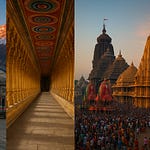Where Time Stands Still and Devotion Breathes
Amidst the ancient folds of the Aravalli Hills, away from the bustling bazaars and regal forts of Jaipur, lies a mystical haven — the Galtaji Temple complex, also known as the Monkey Temple. But to reduce it to just that would be a disservice.
Galtaji is not merely a temple. It is an ecosystem of faith, nature, and centuries-old mythology — a sacred hermitage where saints once meditated, monkeys now roam freely, and kunds (water tanks) brim with spiritual significance.
Etymology & Origin: Why 'Galtaji'?
The name “Galtaji” derives from Rishi Galav, an enlightened sage from ancient times. According to legend, Rishi Galav performed severe penance here for many years, earning divine blessings. The gods, moved by his tapasya, created a perennial stream of holy water — believed to never dry up, even in Rajasthan’s arid climate.
This celestial stream birthed the kunds of Galtaji, and the site became sanctified as a tirtha (pilgrimage site). It is believed that even the sacred Ganga flows spiritually through this site, making it as revered as Haridwar for some devotees.
Historical Background: Built Through Devotion, Preserved Through Faith
The physical structures of the Galtaji Temple complex were constructed in the 18th century by Diwan Rao Kriparam, a courtier in the court of Sawai Jai Singh II, the founder of Jaipur. However, the site's spiritual sanctity predates this by several millennia, mentioned in ancient scriptures and oral traditions passed through the Nath and Vaishnava sects.
Galtaji became a significant Vaishnavite pilgrimage center, especially for followers of the Ramanandi sect, one of the largest branches of Vaishnavism.
Architectural Wonder: A Temple Carved into Nature
Unlike typical temples, Galtaji blends Rajputana architectural style with natural topography. The temple complex is built within a narrow mountain pass, flanked by pink sandstone cliffs. The pavilions, domes, painted walls, and chhatris seem to emerge from the rocks themselves.
It features multiple temples dedicated to:
Lord Hanuman (popular among monkey clans)
Lord Ram, Sita, and Lakshman
Surya Mandir (Sun God Temple) — perched atop the hills with breathtaking sunrise views
Galta Kund, Sita Kund, Ram Kund, and Surya Kund — the sacred water tanks
The Seven Sacred Kunds: Eternal Springs in a Desert Land
The most mystical part of Galtaji is the presence of seven natural kunds — reservoirs fed by an underground spring. These are:
Galta Kund – the holiest and deepest
Ram Kund
Sita Kund
Surya Kund
Hanuman Kund
Brahma Kund
Vishnu Kund
Even during harsh Rajasthani summers, these kunds never run dry — an unsolved hydrological mystery that locals credit to divine intervention.
Rituals & Worship Practices
Puja and Aarti
Morning Aarti begins at sunrise, especially at Surya Mandir, invoking the Sun God.
Hanuman Aarti in the evenings is marked by rhythmic clapping, bhajans, and offerings of boondi, laddoos, and flowers.
Devotees bathe in the kunds as purification rituals before entering the temples.
Bhajans and Kirtans
Ramanandi monks and local bhajan mandalis often chant:
"Shri Ram Jai Ram Jai Jai Ram"
“Hanuman Chalisa” in chorus
Traditional Rajasthani devotional songs that blend folklore with mythology
Special Pujas
Makar Sankranti (January): Thousands take a holy dip
Hanuman Jayanti: Celebrated with massive processions
Purnima (full moon nights): Considered especially auspicious
Spiritual Significance and Mystical Beliefs
Pilgrimage Site: Equal in holiness to Pushkar and Haridwar for many Rajasthanis.
Mystic Energy: Believers report an unexplainable sense of peace and calm, attributing it to centuries of penance performed by yogis and saints.
Monkey Guardians: The monkeys here are considered sacred protectors, believed to be the spiritual descendants of Hanuman’s vanar sena.
The Monkeys of Galtaji: The Real Keepers of the Temple
Notorious yet divine, the thousands of rhesus macaques who reside here aren’t just part of the scenery — they’re legendary.
British naturalist Langur Wala even filmed a documentary on them titled "Monkey Thieves", showing how these monkeys co-exist with humans, and in many cases, even receive offerings from pilgrims.
They are fed fruits, sweets, and water by locals who consider them manifestations of Hanuman.
The Hidden Pathways and the 'Rishi Galav Cave'
Few visitors know of the hidden ascetic cave beyond the main complex — believed to be the very cave where Rishi Galav meditated. Covered with age-old carvings, ash markings, and tridents (trishuls), the cave is untouched by commercial tourism.
Traveler’s Guide: How to Reach and What to Expect
How to Reach Galtaji:
Location: Around 10 km east of Jaipur City
By Air: Jaipur International Airport (15 km away)
By Road: Easily accessible via cab or tuk-tuk
Trek: From Surajpol Gate, take the hiking trail to Surya Mandir, then descend into the valley to reach Galtaji — a must-do for sunrise lovers
Best Time to Visit:
October to March: Pleasant weather, fewer monkeys, more serene
Makar Sankranti (January 14): Grand annual fair and mass holy dip
Devotee Experience: Stories and Anecdotes
“I came here with a heavy heart after losing my mother. One dip in the Galta Kund and the priest told me things about her soul’s journey I hadn’t shared with anyone. I now return every year.” — Rekha Tiwari, Devotee from Ujjain
“The peace here is not of this world. Sitting by the kund as the sun sets behind the Aravallis — it’s where I feel closest to God.” — Yogesh Sharma, Jaipur local
A Place Where Divinity Meets Wilderness
Galtaji isn’t a tourist attraction — it’s a living, breathing force. It stands as a fusion of natural wonder, divine legend, and unshaken faith. From sacred kunds that defy science to monkeys that behave like spiritual sentinels, this place whispers secrets of an older India — one where nature, gods, and men lived in harmony.
Whether you seek moksha, mystery, or mindfulness, Galtaji will not disappoint.
Quick Highlights:
Location: Galtaji Temple is located in East Jaipur, Rajasthan, nestled within the serene folds of the Aravalli Hills.
Deity: The temple complex is primarily dedicated to Lord Ram, Lord Hanuman, and Surya (the Sun God), reflecting a strong Vaishnavite and Surya worship tradition.
Origin: The spiritual sanctity of the site originates from the intense tapasiya (penance) of Sage Galav, after whom the temple is named.
Built By: The present temple structures were commissioned in the 18th century by Diwan Kriparam, a courtier of Maharaja Sawai Jai Singh II.
Key Festivals: Makar Sankranti is the most prominent festival celebrated here with mass pilgrimages and holy dips, followed by Hanuman Jayanti, marked by bhajans and processions.
Sacred Features: Galtaji is home to seven holy kunds (water tanks), an ancient cave believed to be Galav’s meditation site, and large families of monkeys who are considered protectors of the temple.
Specialty: The kunds are fed by a natural spring that never dries up, even in scorching Rajasthan summers — a mystical phenomenon. The temple is also famed for its harmonious blend of nature and devotion.
Ideal Visit Time: The best time to visit is early morning, especially via the Sun Temple (Surya Mandir) trekking route, which offers panoramic sunrise views and spiritual calmness.










